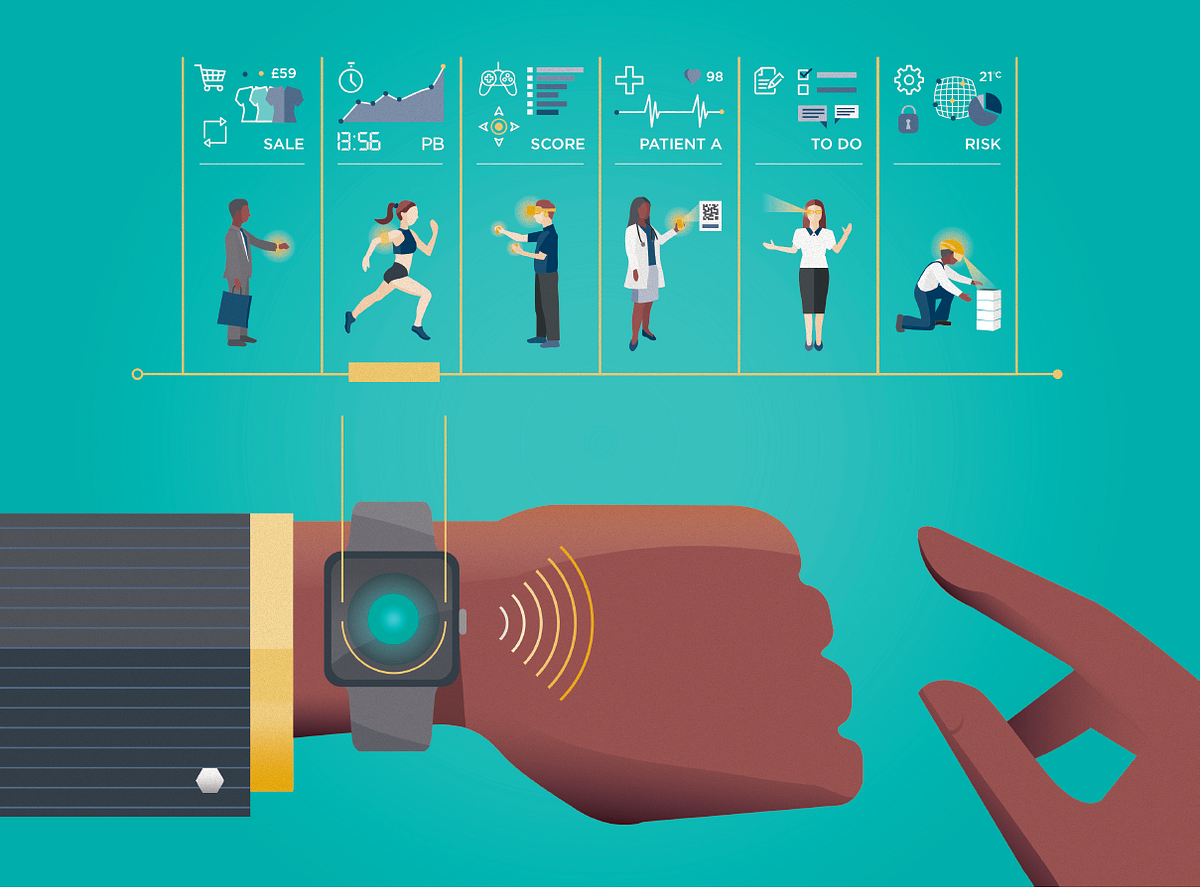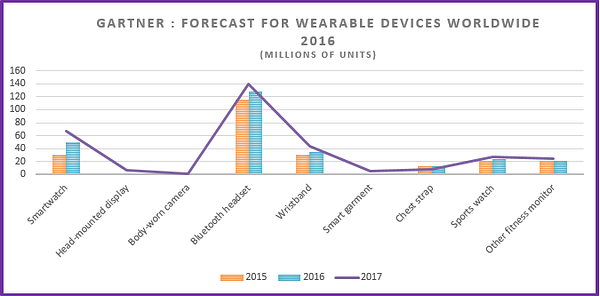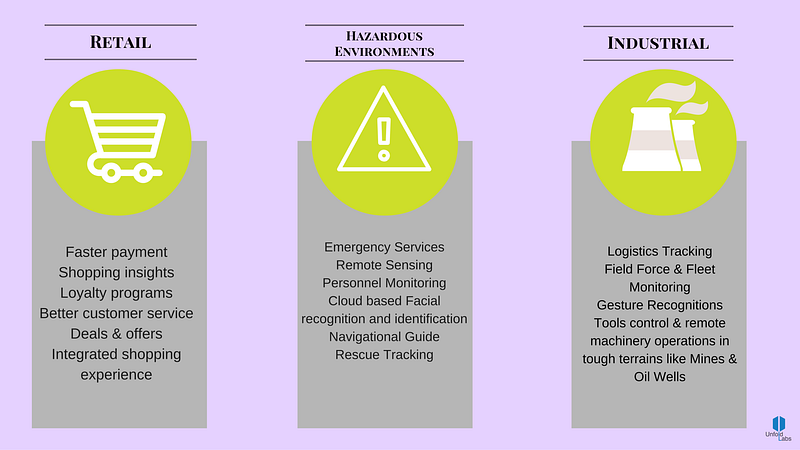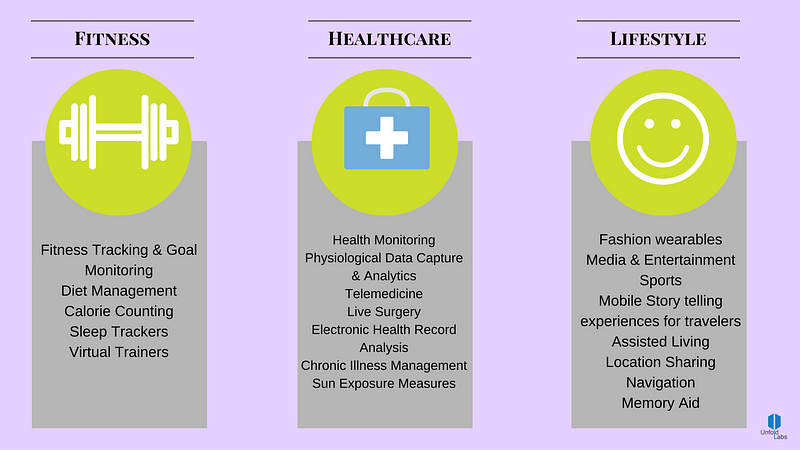WearableTech Unfolded - The Future is Here!

Wearables today have become a statement of sorts and are on the way to becoming an indispensable part of our daily lives — at home, on the go, at work. Blending in with almost everything in different ways — as accessories, clothes, watches, bands, eye-wear and even jewelry, wearables are a mainstream technology fusing fashion and function.
Though wearables were designed to complement the fitness industry, it now finds applications almost everywhere. Many industry sectors are now using wearables as a means of achieving an advantage — a retailer using it to improve overall customer experience, an enterprise using it to improve the health and wellness of its employees, a manufacturer using hands free guidance systems to expedite production or in mining to alert the workforce of potential hazards.
Industry forecast
Popular market research reports predict that the overall market for wearable technology is expected to exceed 30B by 2020 (Source: IdTechEx). Gartner, Inc. forecasts that 275M wearable electronic devices will be sold worldwide in 2016, an increase of 18.4 percent compared to 232M units in 2015. Sales of wearable electronic devices are expected to generate $28.7B in revenue in 2016, of which $11.5B will be from smartwatches. The total dollar market in wearables is forecasted to increase from $6B in 2016 to $25B by 2019.

New developments and investments pioneered by organizations like Apple, Samsung, SAP, Nike and many crowdfunded kickstarters, encourage research and innovation for the wearables technology.
Wearables are here to stay, but many technology experts believe that the technology is in its nascent stages and a lot of work remains to be done. However, the increasing popularity of smartwatches and customer preferences for sophisticated gadgets is expected to propel the growth of the wearables market. Innovation in e-textiles, wearable infotainment, wearables driven healthcare and adoption by enterprises is expected to make this technology an integral part of daily life.
The many avatars of Wearables
Wearables may have started primarily in the fitness industry, but now find applications beyond monitoring health and keeping time. Consumers now expect a wearable to be fashion forward, easy to use and integrate with their lifestyle effortlessly. They appear in newer models, shapes and sizes every day to suit the needs of personal and business users alike.
Smartwatches
Motorola, Samsung & LG continue to lead the way for Smartwatches with Android Wear, flaunting both round and square shapes with traditional or modern looks — a watch to suit every pocket and style. On the other hand, the Apple Watch stays in its square shape with its Sports, Classic and Special Editions. Pebble Time, a completely crowdfunded project remains instrumental in changing the definition of timepieces with its innovative designs and works well with both iOS and Android smartphones.
Activity Trackers, Sleep Monitors & Fitness Bands
The fitness and activity trackers are the most commonly used wearables today. Top of the charts in this category are Fitbit and Jawbone. Others notable brands in this space are Garmin, Misfit Ray and Microsoft Band — each with its own signature styles to choose from.

Glasses & Lenses
Google stands as the pioneer in eye wearables with its Google Glass. Despite the initial hiccups, Google Glass shows us how optical head-mounted displays with natural language and touch pad based commands can add value to day to day functions. Wi-Fi and Bluetooth enabled, Glass performs most of the functions that a smartphone does and more with the advantage of hands-free actions. It helps augment the world of a user with an inbuilt camera, microphone, video calling and GPS. There is a lot more research being done in this segment and is expected to bring in better devices and use cases.
Head Mounted Devices
Head mounted devices (HMD) go beyond Virtual Reality hardware with new designs for business use. HMDs are expected to be put to use for augmenting machinery checks, maintenance and repairs in organizations. These kind of wearables are also useful in improving safety and effectiveness of personnel in hazardous environments.
Garments
Smart sensing fabrics — combining tiny sensors within a garment is another interesting application of wearables. Once the garment is connected with a transmitter, it is possible to setup a body monitoring system with a Bluetooth or Wi-Fi powered smartphones. The fabric captures data indicating respiration, heart rate and other key physiological metrics. These smart garments combined with alerts and notifications will help in effective health monitoring and to ensure faster actions at time of emergencies. This is another segment that is expected to grow exponentially with smart shoes, smart socks etc.
Innovative & Useful Applications of Wearables
There are many ingenious and innovative ways by which wearables can enhance the lives of people and enterprises. Applications for wearables is multiplying fast as numerous sectors find ways of putting this tech to work. Aiming to offer instant and hands-free wearable intelligence, this technology finds applications in the areas of Health & Medicine, Security & Military, Lifestyle, Assisted Living and even Education. Wearables may soon become a part of the BYOD array of devices and are bound to improve customer and employee engagement through analytics and context aware computing.


Mashing Up Technologies and Wearing Them Too!!
Wearables bind together complementary techniques like Big Data, Business Intelligence, Analytics, AR and VR to offer the best experience for a consumer or enterprise.
Internet of Things (IoT)
Wearable technology with its network of Wearable devices, sensors, electronics and the software driving is facilitated by the concept of the Internet of Things — enabling seamless data exchange with other connected devices and manufacturers with minimum human intervention.
Remote Sensing & Remote Monitoring
As one of the main goals of wearables is to track human activities and their environments and log them, sensors play a huge role by turning into barometers, thermometers, air humidity sensors, pedometers and heart rate monitors. Smartly integrated into the scheme of things, sensors are one of the core technologies required for Wearables. Remote monitoring becomes possible with remote sensing of bio-parameters as well as environmental parameters to supervise distant conditions from a remote location.
Communication, Voice Transmission & Voice Based Techniques
Communication through advanced electronics and other location sensing technologies makes the world of the Wearables complete. Bluetooth & Wi-Fi play an important role while designing wearables. Audio transmission gets a completely new makeover with cool techniques adopted into headphones, ear-plugs and ear buds designed for wearables for Hearing aids, Military communication, Sports headphones, Diving & Swimming. Voice based techniques relying on Google Now, Apple Siri or Microsoft Cortana empower the wearables with this sensory technique to make the hands available for other work.
Microprocessors & Microchips
Big players like Intel, Qualcomm, Mediatek have launched niche processors for wearables by optimizing for size, battery & performance. Some examples are Intel Curie and Mediatek Mt2502. Microchips give an impetus to the implanted devices; fostering hands-free access to computers and advanced electronics. Wearables are implanted under the human skin, and this market is set to see phenomenal growth considering the fashion statement associated with it.
Smartphones — The Indispensable part of the Ecosystem
Smartphones combined with the right apps and wearables become an essential and central hub for communication and connectivity providing the perfect customer experience for multiple wearable devices.
Our Take
We expect wearables will continue to grow and enhance the quality of life of consumers in most segments. However, as a new technology — despite the many benefits it offers, it also faces challenges in adoption.
Devices: Multiple wearables are available in the market today — each with different prices, features and functions thus giving quite a few choices to consumers. However, data gathered from these devices are fragmented, not accessible at one place and not provided in a meaningful format, which may leave the consumer confused and more reluctant to adopt wearables.
Network: Most of the wearables available today are connected to a smartphone. We expect Wearables to expand and connect directly to external (3G/4G) networks and reduce dependency on smartphones.
Applications: Another major concern of consumers in adopting wearables is Privacy and Security. Consumers regardless of demographic have concerns about privacy and how wearables may impact them. Each wearable collects personal user data and therefore policies must be put in place to ensure that the data collected is used for the improvement and enrichment of the user and not for any other purposes.

